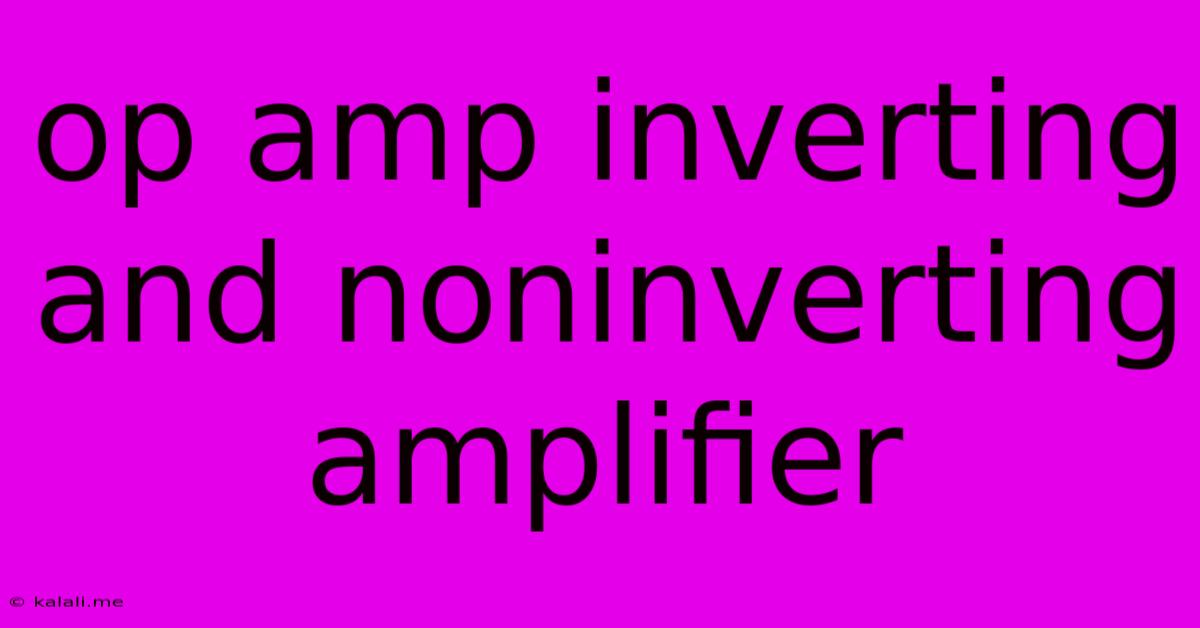Op Amp Inverting And Noninverting Amplifier
Kalali
Jun 04, 2025 · 4 min read

Table of Contents
Understanding Operational Amplifiers: Inverting and Non-Inverting Configurations
Operational amplifiers (op-amps) are versatile integrated circuits (ICs) that form the cornerstone of many analog circuits. Their ability to amplify signals makes them crucial in applications ranging from audio processing to instrumentation. This article will delve into two fundamental op-amp configurations: the inverting and non-inverting amplifiers, explaining their operation, characteristics, and applications.
Understanding the Basics of an Op-Amp
Before diving into specific configurations, let's briefly review the key characteristics of an ideal op-amp:
- High Open-Loop Gain: An ideal op-amp possesses infinite gain. In reality, op-amps have very high open-loop gain, typically in the range of 10<sup>5</sup> to 10<sup>6</sup>.
- High Input Impedance: Ideally, the input impedance is infinite, meaning it draws no current from the input source.
- Low Output Impedance: Ideally, the output impedance is zero, allowing it to drive various loads without significant voltage drop.
- Zero Input Offset Voltage: An ideal op-amp has zero voltage difference between the input terminals when the output is zero.
- Infinite Bandwidth: Ideally, it can amplify signals of any frequency without attenuation.
These characteristics, although not perfectly achievable in real-world op-amps, provide a good foundation for understanding their behavior.
The Inverting Amplifier
The inverting amplifier configuration is characterized by the input signal being applied to the inverting terminal (-) of the op-amp, while the non-inverting terminal (+) is grounded. A feedback resistor (Rf) connects the output to the inverting terminal, forming a negative feedback loop. Another resistor (Rin) connects the input signal to the inverting terminal.
Circuit Diagram and Analysis
[You would insert a simple circuit diagram of an inverting op-amp here. Since I can't create images, imagine a simple diagram with Vin connected through Rin to the inverting input, Rf connecting the output to the inverting input, and the non-inverting input grounded.]
Using Kirchhoff's Current Law (KCL) at the inverting node and applying the ideal op-amp assumptions (infinite input impedance and virtual short circuit between the inputs), we can derive the voltage gain:
- Av = -Rf/Rin
This equation shows that the gain is determined by the ratio of the feedback resistor (Rf) to the input resistor (Rin). The negative sign indicates that the output signal is inverted with respect to the input signal – a positive input results in a negative output, and vice versa. This configuration provides a precise and adjustable gain, making it useful in various applications.
Applications of Inverting Amplifiers
- Signal Attenuation/Amplification: By selecting appropriate resistor values, the inverting amplifier can attenuate or amplify signals precisely.
- Subtractors: With the addition of another input, this configuration can perform subtraction operations.
- Instrumentation Amplifiers (with modifications): While not directly, the inverting amplifier forms a building block for more sophisticated instrumentation amplifiers.
The Non-Inverting Amplifier
In contrast to the inverting amplifier, the non-inverting amplifier applies the input signal to the non-inverting terminal (+). The inverting terminal is connected to the output through a feedback resistor (Rf), and a resistor (Rin) connects the inverting terminal to ground.
Circuit Diagram and Analysis
[You would insert a simple circuit diagram of a non-inverting op-amp here. Imagine a diagram with Vin connected to the non-inverting input, Rf connecting the output to the inverting input, and Rin connecting the inverting input to ground.]
Applying KCL and the ideal op-amp assumptions, the voltage gain for a non-inverting amplifier is:
- Av = 1 + (Rf/Rin)
Notice that the gain is always greater than 1, and it's positive, meaning the output signal is in-phase with the input signal.
Applications of Non-Inverting Amplifiers
- Voltage Followers (Buffer Amplifiers): When Rf is 0 and Rin is infinite (open circuit), the gain becomes 1, creating a voltage follower that isolates the input and output circuits. This is useful for impedance matching.
- High Impedance Input Stages: The non-inverting configuration offers high input impedance, making it suitable for applications where the input source has a high impedance.
- Summing Amplifiers (with modifications): Similar to inverting amplifiers, modifications allow this configuration to sum multiple input signals.
Conclusion
Both inverting and non-inverting amplifier configurations are crucial components in analog circuit design. Understanding their characteristics and applications is essential for anyone working with op-amps. The choice between them often depends on the specific requirements of the application, primarily considering whether signal inversion is needed and the desired input impedance. By carefully selecting resistor values, designers can achieve precise amplification or attenuation to meet the demands of their projects.
Latest Posts
Latest Posts
-
What Is The Opposite Of An Acid
Jun 06, 2025
-
What Does Sudo Do In Discord
Jun 06, 2025
-
Receiving Mail For Someone Else At My Address
Jun 06, 2025
-
Logic Gate That Flips Its Input
Jun 06, 2025
-
Main Water Shutoff Valve From Well
Jun 06, 2025
Related Post
Thank you for visiting our website which covers about Op Amp Inverting And Noninverting Amplifier . We hope the information provided has been useful to you. Feel free to contact us if you have any questions or need further assistance. See you next time and don't miss to bookmark.